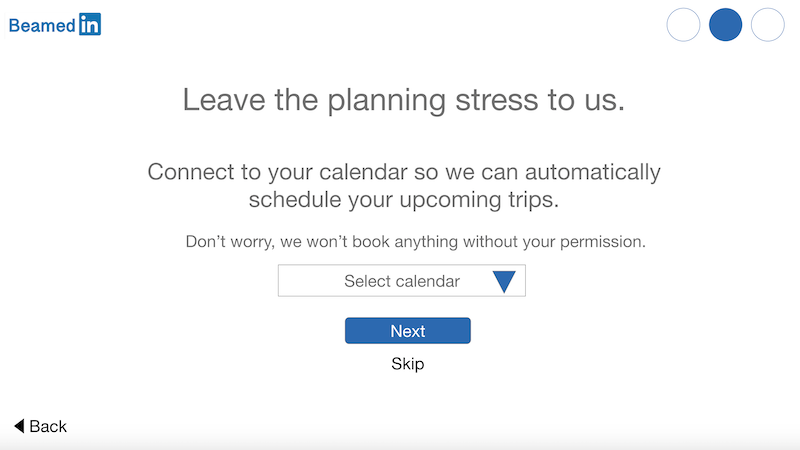Detailed Content Design Decisions
Page 1:
“Welcome, [user’s name]!” — Alerts the user that they have exited the sign-in phase and entered the set-up phase of the product.
“Let’s confirm your address, connect to your calendar, and ease your travel experience.” —Gives the user a surface-level understanding of what is to come with each stage of onboarding the service.
“Enter your address.” — This is a quick command to let the user know what they need to do during this stage of the process.
“You will leave from and return to this location.” — This gives the user context as to why LinkedIn is looking for the user’s address.
Included “Postal Code” instead of “Zip Code” to stay consistent with LinkedIn’s existing onboarding process.
“Next” — If not all fields required are filled out, the user will get an error message saying “Error: all sections required.”
“Skip” option not included because this is information that is essential to the service. Without a place to return to, the user cannot teleport to another location.
Page 2:
“Leave the planning stress to us.” — This is a short phrase meant to be comforting to the user. It is intentionally short to allow for localization and translation.
“Connect to your calendar so we can automatically schedule your upcoming trips.” — This tells the user what they need to do and gives them context as to why this is required.
“Don’t worry, we won’t book anything without your permission.” — This is meant to ease the user’s nerves that unnecessary trips would be booked without their consent.
“Select calendar.” — Generates an auto-populated list of the user’s local calendars (Outlook, Teams, Apple Calendar, Google Calendar) that they can choose from to sync with the LinkedIn service.
“Next” and “Skip” are included to move onto the next stage. Connecting the calendar is not necessary to the service and therefore can be skipped.
Page 3:
“Tell us what you need to know to make your trips better.” — Immediately tells the user what the product needs to make the service unique to them.
“Select items below to feature on your homepage. You can always change this later.” — The homepage will include information the user will want to know about their destination. “Change this later” lowers the stakes of this step, the goal is personalization and user preferences can change.
Various icons — suggestions as to what the user might want to know about for their trip. Items are focused on professional trips. Check marks were included instead of words to reduce the amount of text on the page. User clicks on a check mark to include it.
“Finish” — This informs the user that they have graduated the onboarding process and are ready to use the product.


